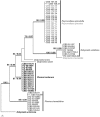Analysis of the mating-type loci of co-occurring and phylogenetically related species of Ascochyta and Phoma
- PMID: 22014305
- PMCID: PMC6638728
- DOI: 10.1111/j.1364-3703.2011.00751.x
Analysis of the mating-type loci of co-occurring and phylogenetically related species of Ascochyta and Phoma
Abstract
Ascochyta and Phoma are fungal genera containing several important plant pathogenic species. These genera are morphologically similar, and recent molecular studies performed to unravel their phylogeny have resulted in the establishment of several new genera within the newly erected Didymellaceae family. An analysis of the structure of fungal mating-type genes can contribute to a better understanding of the taxonomic relationships of these plant pathogens, and may shed some light on their evolution and on differences in sexual strategy and pathogenicity. We analysed the mating-type loci of phylogenetically closely related Ascochyta and Phoma species (Phoma clematidina, Didymella vitalbina, Didymella clematidis, Peyronellaea pinodes and Peyronellaea pinodella) that co-occur on the same hosts, either on Clematis or Pisum. The results confirm that the mating-type genes provide the information to distinguish between the homothallic Pey. pinodes (formerly Ascochyta pinodes) and the heterothallic Pey. pinodella (formerly Phoma pinodella), and indicate the close phylogenetic relationship between these two species that are part of the disease complex responsible for Ascochyta blight on pea. Furthermore, our analysis of the mating-type genes of the fungal species responsible for causing wilt of Clematis sp. revealed that the heterothallic D. vitalbina (Phoma anamorph) is more closely related to the homothallic D. clematidis (Ascochyta anamorph) than to the heterothallic P. clematidina. Finally, our results indicate that homothallism in D. clematidis resulted from a single crossover between MAT1-1 and MAT1-2 sequences of heterothallic ancestors, whereas a single crossover event followed by an inversion of a fused MAT1/2 locus resulted in homothallism in Pey. pinodes.
© 2011 THE AUTHORS. MOLECULAR PLANT PATHOLOGY © 2011 BSPP AND BLACKWELL PUBLISHING LTD.
Figures





Similar articles
-
A new species of Phoma causes ascochyta blight symptoms on field peas (Pisum sativum) in South Australia.Mycologia. 2009 Jan-Feb;101(1):120-8. doi: 10.3852/07-199. Mycologia. 2009. PMID: 19271674
-
Multiple Didymella teleomorphs are linked to the Phoma clematidina morphotype.Persoonia. 2009 Jun;22:56-62. doi: 10.3767/003158509X427808. Epub 2009 Mar 3. Persoonia. 2009. PMID: 20198138 Free PMC article.
-
Comparison of cultural growth and in planta quantification of Didymella pinodes, Phoma koolunga and Phoma medicaginis var. pinodella, causal agents of ascochyta blight on field pea (Pisum sativum).Mycologia. 2012 Jan-Feb;104(1):93-101. doi: 10.3852/11-118. Epub 2011 Sep 20. Mycologia. 2012. PMID: 21933927
-
Phoma-like fungi on soybeans.Crit Rev Microbiol. 2014 Feb;40(1):49-62. doi: 10.3109/1040841X.2012.755948. Epub 2013 Jan 31. Crit Rev Microbiol. 2014. PMID: 23363325 Review.
-
Phytotoxic Metabolites Produced by Legume-Associated Ascochyta and Its Related Genera in the Dothideomycetes.Toxins (Basel). 2019 Oct 29;11(11):627. doi: 10.3390/toxins11110627. Toxins (Basel). 2019. PMID: 31671808 Free PMC article. Review.
Cited by
-
Genome and Transcriptome Analysis of Ascochyta pisi Provides Insights into the Pathogenesis of Ascochyta Blight of Pea.Microbiol Spectr. 2023 Feb 14;11(1):e0448822. doi: 10.1128/spectrum.04488-22. Epub 2023 Jan 16. Microbiol Spectr. 2023. PMID: 36645309 Free PMC article.
-
Repeated evolution of self-compatibility for reproductive assurance.Nat Commun. 2018 Apr 24;9(1):1639. doi: 10.1038/s41467-018-04054-6. Nat Commun. 2018. PMID: 29691402 Free PMC article.
-
The Sclerotinia sclerotiorum mating type locus (MAT) contains a 3.6-kb region that is inverted in every meiotic generation.PLoS One. 2013;8(2):e56895. doi: 10.1371/journal.pone.0056895. Epub 2013 Feb 15. PLoS One. 2013. PMID: 23457637 Free PMC article.
-
Mixed-reproductive strategies, competitive mating-type distribution and life cycle of fourteen black morel species.Sci Rep. 2017 May 4;7(1):1493. doi: 10.1038/s41598-017-01682-8. Sci Rep. 2017. PMID: 28473711 Free PMC article.
-
Pondering Mating: Pneumocystis jirovecii, the Human Lung Pathogen, Selfs without Mating Type Switching, in Contrast to Its Close Relative Schizosaccharomyces pombe.mBio. 2015 May 5;6(3):e00583-15. doi: 10.1128/mBio.00583-15. mBio. 2015. PMID: 25944864 Free PMC article. No abstract available.
References
-
- Aveskamp, M.M. , De Gruyter, J. and Crous, P.W. (2008) Biology and recent developments in the systematics of Phoma, a complex genus of major quarantine significance. Fungal Divers. 31, 1–18.
-
- Aveskamp, M.M. , Verkley, G.J.M. , de Gruyter, J. , Murace, M.A. , Perello, A. , Woudenberg, J.H.C. , Groenewald, J.Z. and Crous, P.W. (2009a) DNA phylogeny reveals polyphyly of Phoma section Peyronellaea and multiple taxonomic novelties. Mycologia, 101, 363–382. - PubMed
-
- Aveskamp, M.M. , Woudenberg, J.H.C. , De Gruyter, J. , Turco, E. , Groenewald, J.Z. and Crous, P.W. (2009b) Development of taxon‐specific sequence characterized amplified region (SCAR) markers based on actin sequences and DNA amplification fingerprinting (DAF): a case study in the Phoma exigua species complex. Mol. Plant Pathol. 10, 403–414. - PMC - PubMed
Publication types
MeSH terms
Associated data
- Actions
- Actions
- Actions
- Actions
- Actions
- Actions
- Actions
- Actions
- Actions
- Actions
- Actions
- Actions
- Actions
- Actions
- Actions
- Actions
- Actions
- Actions
- Actions
- Actions
- Actions
- Actions
- Actions
- Actions
- Actions
- Actions
- Actions
- Actions
- Actions
- Actions
- Actions
- Actions
- Actions
- Actions
- Actions
- Actions
- Actions
LinkOut - more resources
Full Text Sources

